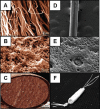The Achilles tendon: fundamental properties and mechanisms governing healing
- PMID: 25332943
- PMCID: PMC4187594
The Achilles tendon: fundamental properties and mechanisms governing healing
Abstract
This review highlights recent research on Achilles tendon healing, and comments on the current clinical controversy surrounding the diagnosis and treatment of injury. The processes of Achilles tendon healing, as demonstrated through changes in its structure, composition, and biomechanics, are reviewed. Finally, a review of tendon developmental biology and mechano transductive pathways is completed to recognize recent efforts to augment injured Achilles tendons, and to suggest potential future strategies for therapeutic intervention and functional tissue engineering. Despite an abundance of clinical evidence suggesting that current treatments and rehabilitation strategies for Achilles tendon ruptures are equivocal, significant questions remain to fully elucidate the basic science mechanisms governing Achilles tendon injury, healing, treatment, and rehabilitation.
Keywords: Achilles tendon rupture; biomechanics; developmental biology; foot and ankle; injury; tendinopathy; tissue engineering.
Figures






References
-
- Kotian SR, Sachin KS, Bhat KM. Bifurcated plantaris with rare relations to the neurovascular bundle in the popliteal fossa. Anat Sci Int. 2013;88:239–241. - PubMed
-
- Fukashiro S, Komi PV, Jarvinen M, Miyashita M. In vivo Achilles tendon loading during jumping in humans. Eur J Appl Physiol Occup Physiol. 1995;71:453–458. - PubMed
-
- Maffulli N. Rupture of the Achilles tendon. J Bone Joint Surg Am. 1999;81:1019–1036. - PubMed
-
- Jarvinen TA, Kannus P, Maffulli N, Khan KM. Achilles tendon disorders: etiology and epidemiology. Foot Ankle Clin. 2005;10:255–266. - PubMed
-
- Nyyssonen T, Luthje P, Kroger H. The increasing incidence and difference in sex distribution of Achilles tendon rupture in Finland in 1987–1999. Scand J Surg. 2008;97:272–275. - PubMed
Publication types
Grants and funding
LinkOut - more resources
Full Text Sources
